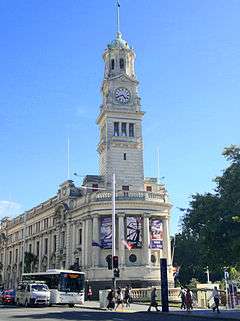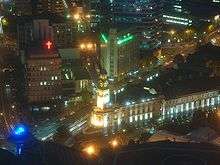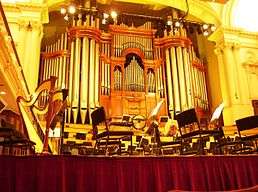Auckland Town Hall
| Auckland Town Hall | |
|---|---|
 The Town Hall from Queen Street adjacent to nearby Aotea Square. | |
| General information | |
| Type | Town hall |
| Architectural style | Italian Renaissance Revival |
| Location | Auckland, New Zealand |
| Address | Queen Street |
| Construction started | 1909 |
| Completed | 1911 |
| Inaugurated | 14 December 1911 |
| Renovated | 1994-1997 |
| Cost | £126,000 |
| Renovation cost | NZ$33 million |
| Owner | Auckland Council |
| Height | 45m |
| Design and construction | |
| Architect | JJ and EJ Clarke |
| Renovating team | |
| Structural engineer | Sinclair Knight Merz |
| Designated | 27-Jul-1988 |
| Reference no. | 549 |
The Auckland Town Hall is a historic building on Queen Street in downtown Auckland, New Zealand, known both for its original and ongoing use for administrative functions (such as Council meetings and hearings), as well as for its famed Great Hall and its separate Concert Chamber. The Town Hall and its surrounding context is highly protected as a 'Category A' heritage place in the city's district plan.
History


Building
Opened on 14 December 1911 by Lord Islington, then the Governor of New Zealand, the building is one of the most prominent heritage structures on Queen Street. Costing £126,000 to construct, it was designed by Melbourne architects, JJ & EJ Clarke, their Italian Renaissance Revival building selected from amongst 46 proposals. The five-storey building was specially designed to fit the wedge-shaped piece of land that had been acquired for it at the meeting of Queen Street and Grey Street in the 1870s. It bears a striking resemblance to the new Lambeth Town Hall at Brixton, London built around the same time. The town hall formed Auckland's first permanent seat of both administration and entertainment in the city's history, with its Great Hall (seating 1,673 people) modelled on the Gewandhaus in Leipzig, and being considered as having among the finest acoustics in the world.
The exterior is constructed of two types of stone, the ground floor is made of a dark volcanic basalt, heavily rusticated, which contrasts with the pale stonework of the upper stories. Oamaru limestone from the south island was used for the upper part of the building. The lower part is often assumed to be Auckland Basalt but was actually sourced from Melbourne. This was probably due to the architects already having a history of sourcing consistently good quality stone from the quarries there as well as them probably having better heavy duty steam saws to handle the notoriously difficult stone.
The interior contains several varieties of English ceramic surfaces - tessalated floors and glazed ceramic wall tiles. The semi-circular Council Chamber is provided with wood panelling and Art-Nouveau style electric light fittings and stained glass are features of all the main rooms. The ceilings throughout all the main floors are ornamented with good quality plasterwork, the Great Chamber being the most elaborate. The great four sided clock in the tower was donated by Arthur Myers MP (former Mayor) and the Pipe Organ by Sir Henry Brett. The Town hall project was championed by Myers before and during his time as Mayor (1905-1909) and one of his last acts as Mayor was to lay the foundation stone.
The Town Hall's interior was extensively restored from 1994-1997 for NZ$33 million, partially because the unreinforced masonry structure did not meet earthquake standards, especially as a gathering place. Sinclair Knight Merz pioneered various techniques to reinforce the structure without substantially changing the heritage character of the building.[1] The exterior has recently (2007) undergone some restoration work as well.
A number of ornamental details on the exterior had been removed in the 1950s due to earthquake concerns, and some of the Oamaru limestone was damaged during aggressive stone cleaning. After careful research and analysis, these were replaced during the restoration by new limestone sourced from the same levels of the North Otago quarry that provided the original stone. Interior acoustic performance was corrected through the removal of earlier ill-judged and obtrusive intervention measures, and their replacement by less-visible and more effective treatments. Interior paintwork was restored throughout to the original Edwardian-era colours. Complex fragmented porcelain and glazed ceramic tiling was restored with exact new purpose-made replicas in the lavish main entrance foyer. The original carpet was recreated (for reference a small portion of the original was left in one corner of the Council Chamber) The stained-glass windows were restored and (where necessary) rebuilt, and the entire building was unobtrusively fire protected.
Organ

The Town Hall organ, also dating from 1911, is the largest musical instrument in the country,[2] and is itself a 'Protected Object' in New Zealand law. It was extensively remodelled in 1969-1970 when the organ reform movement reached New Zealand, significantly altering and reducing the original Romantic-era power, discarding many parts of the original, and adding new ones to produce a then-fashionable Baroque sound.
The resulting compromised instrument was dismantled in January 2008 for restoration and rebuilding. The rebuilt organ, incorporating remaining parts of the 1911 original, some recently recovered components, and new elements, was built by Orgelbau Klais of Bonn, Germany. It was to return at the end of 2008, to be reassembled as the country's largest (and once again most powerful) organ.[3]
Auckland City had committed itself to providing NZ$3 million to the restoration project, with a $500,000 remainder obtained via private fundraising. The restored organ was officially unveiled on 21 March 2010, with a specially commissioned symphony.
Auckland Philharmonia Orchestra
In early February 2016, the administration staff of New Zealand's Metropolitan Orchestra, the Auckland Philharmonia Orchestra, moved into the vacant former mayoral office suite, making the Town Hall, where the orchestra largely performs, its new home.[4]
References
- ↑ The Engineering Heritage of Auckland (dynamic link from the 'Heritage Walks' website of IPENZ)
- ↑ "Restored Auckland Town hall organ ready to sing". CityScene. Auckland City Council. 7 March 2010. p. 1.
- ↑ (The detailed stop list, from Orgelbau Klais' website. Accessed 2012-11-24.)
- ↑ New Zealand Herald. "New Town Hall base for city's orchestra". New Zealand Herald. Retrieved 19 April 2016.
External links
- Auckland Town Hall (official website)
- "Auckland Town Hall". Register of Historic Places. Heritage New Zealand.
- Photographs of Auckland Town Hall held in Auckland Libraries' heritage collections.
Coordinates: 36°51′10″S 174°45′49″E / 36.8526856°S 174.7634912°E